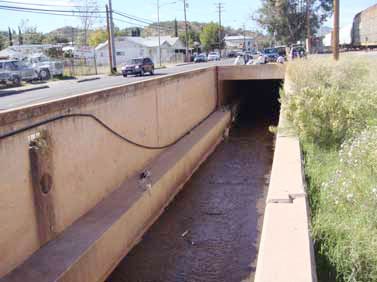Article written by FOSCR Board member Ben Lomeli

Every storm that hits Nogales, AZ puts pressure on the deteriorating sewage pipe that carries 14 million gallons of sewage daily, mostly from Mexico, right through the small city of Nogales, AZ to the Nogales International Wastewater Treatment Plant (NIWTP) in Rio Rico, AZ.
This pipe, the International Outfall Interceptor (IOI), was constructed in 1971. Its path to the NIWTP lies mostly under the Nogales Wash. It is protected from erosive flood flows by the concrete-lined floor of the Wash and several feet of dirt.
Because of upstream urbanization and its deteriorated condition, the IOI is in danger of becoming exposed and bursting every year during heavy summer monsoon flood flows in the Nogales Wash. Additionally, the IOI continues to leak raw sewage into the groundwater aquifer system that provides drinking water for most of the community.
Friends of the Santa Cruz River commissioned a short video documenting the IOI problem to inform as many people as possible and to create a unified voice to urge federal decision makers to fund a proper repair for this failing infrastructure complex. This film can be viewed on the website.
The Nogales Wash is located in an arid-semiarid desert landscape. It lies within the Upper Santa Cruz River Basin in southeastern Arizona. There are two major precipitation periods in the typical southeastern Arizona water year. The first and most dramatic is the summer monsoon season (July–Sept), in which 50% of annual precipitation occurs. A secondary wet season during the fall and winter months is caused by Pacific frontal storm movement.
Potential climate change-related impacts are of concern for Nogales Wash (and the IOI) because all credible predictions are for warmer and drier conditions overall, but with less frequent but more intense storms.
Detention basins constructed in Mexico are too few, too small (appear to be designed for about a 25-year storm), and have quickly filled up with sediments. Many more are needed and all need to be regularly maintained. Watershed improvements are also needed to stabilize eroding soils and thus reduce excessive sediment flows. Revegetation of bare soils, water-harvesting, erosion control, retro-fitting of stormwater BMPs (Best Management Practices) and LID (Low Impact Development) approaches would all help reduce stormwater peak flows and excessive sediment transport.
Therefore, as long as the contributing watershed in Mexico continues to produce abrasive sediment-laden peak flows that far exceed the conveyance capacities of Nogales Wash, all our local stormwater infrastructure remains at risk. As long as the IOI remains underneath the deteriorated unstable and undersized Nogales Wash, the threat of IOI ruptures remains a reality that will most likely be increased by climate change.
NOTE: A version of this article was also published in “Canyon Echo,” Sierra Club Arizona”s Summer 2017 Newsletter. Click to download a .pdf of the article found on page 11.
